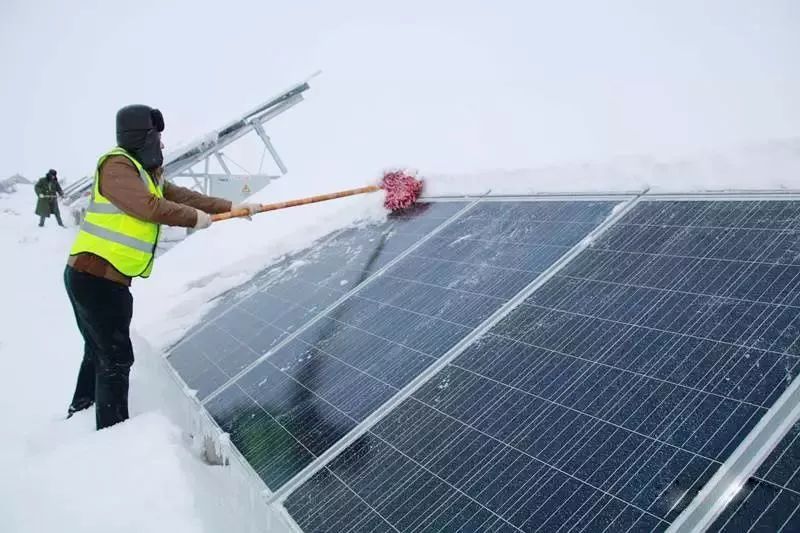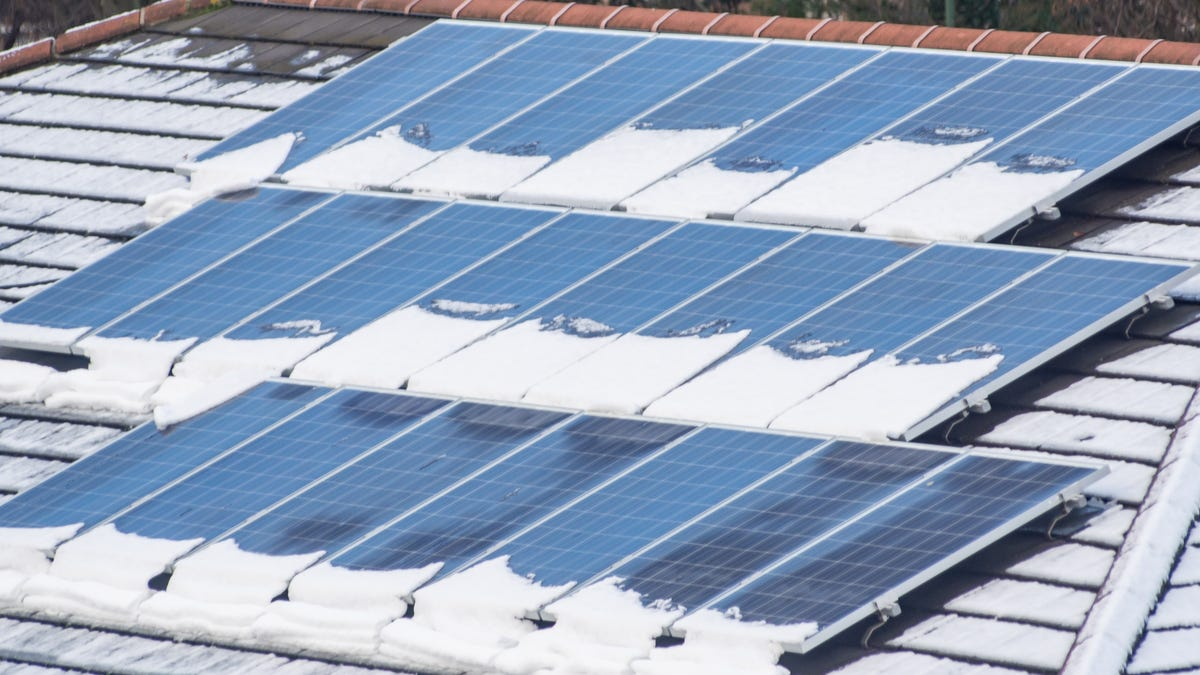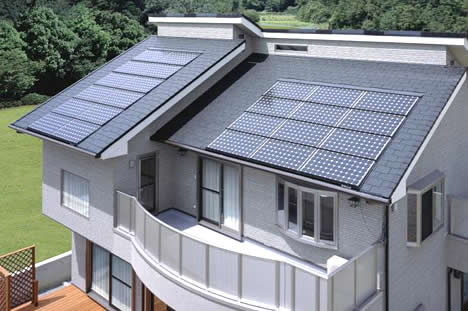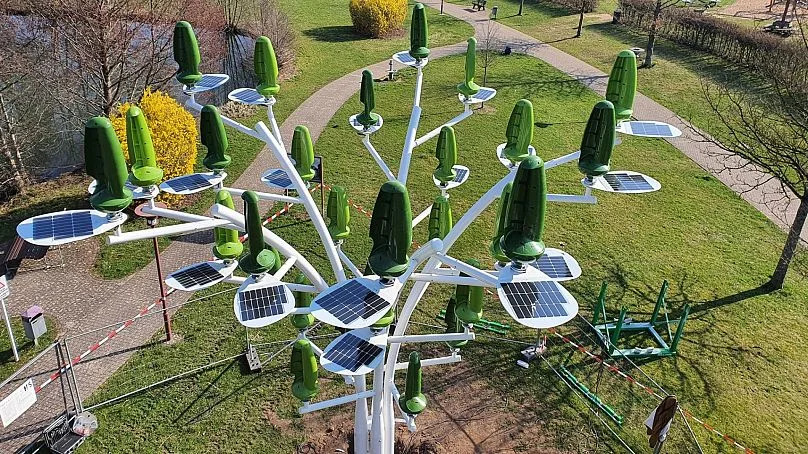Snow, ice and cold are coming for the northern hemisphere. Here's what you can do throughout the winter to keep you solar panels producing as much as they can.
Too much ice and snow on your roof can hurt the efficiency of your solar panels.
Installing solar panels can be a move toward long-term energy savings for a lot of people. Though inflation is cooling, energy costs have increased for a lot of people over the past two years. While solar costs have also risen with inflation, their cost is falling overall and can be subsidized with the 30% federal tax credit. If you've invested in solar, you won't want to leave any electricity production (and the associated savings) on the table. Winter weather can add a few obstacles to that goal.
Solar panels work just as well in the winter as in the summer. (Maybe even better. Cool temperatures can keep solar panels running at their most efficient.) But shorter cloudy days, snow and ice accumulation and the sun lower in the sky all reduce the amount of sun available. If solar panels work better in the cold, they have less sun to work with.
You can mitigate some of these effects. You might not be able to do much about the clouds in the sky, but you can do something about the snow on your panels. With just a bit of extra work, you can get a bit more energy out of your solar panels through the winter than you would otherwise.
We have other solar tips, from how to find a reputable installer among our favorite installers to how to avoid a bad solar deal. Check out how to save money and electricity around the house and find answers to all your solar questions.

Remove heavy snow from your panels
If you live in an area that gets snow, it's natural that some will land on your solar panels. And that's not necessarily a bad thing. Light snowfall is likely to melt fairly quickly. And there may actually be some benefit to snow on your solar panels since it can clean your panels as it melts or slides off.
While some snow on your solar panels is fine, watch out for excess snow accumulation. Solar panels that are covered in snow simply won't capture sunlight in the same way. Additionally, heavy snow can result in too much weight on your solar panels, putting stress on the mounting points.
If you're going to clean snow off your solar panels, be sure to use the right tool. A rough brush or rake can damage your solar panels. Instead, use a soft snow brush that will clean the snow off without scratching the surface of your panels. Again, it's always a good idea to check with your provider to make sure you won't void your warranty.
Reduce your energy usage (or prepare to pay more for electricity)
Solar panels can still capture sunlight and create energy for your home during the winter. But because there are fewer daylight hours, you can also expect your solar panels to produce less energy than they might during the summer. As a result, you may either need to reduce your energy usage or prepare to pay a higher electricity bill. The good news is that there are plenty of ways to reduce your energy usage, including:
- Switch to energy-efficient light bulbs. They last longer and perform better. In general, a 60-watt traditional light bulb can be replaced with a 15-watt energy-efficient bulb.
- Turn off lights and appliances you aren't using. While most of us know we're wasting energy when we leave these things on, we forget that it actually impacts our wallets.
- Unplug small appliances you aren't using. Even when they aren't in use, they can use a small amount of electricity, which adds to your energy bill.
- Turn down your thermostat. You can save money by turning the temperature in your home down a few degrees. Wear layered clothing to make yourself more comfortable.
- Check your home's insulation. If your home has poor insulation, more heat will escape, which will cost you money.
Adjust the angle of your panels
The sun sits lower in the sky during winter and will likely hit your solar panels at a shallower and less efficient angle. Adjusting the angle of your solar panels so the sun hits them more directly will boost electricity generation. Most people won't be able to, since solar panels are typically mounted on fixed racks but, for those who can, adjusting the angle can get a bit more sun to your panels.
Because the sun is lower in the sky during the winter than in the summer, you'll want your panels at a steeper angle during those months. Some sources suggest a winter angle of your latitude plus 10-15 degrees. In Chicago, for example, that would be an angle between 52 and 57 degrees. (Chicago's latitude is about 42 degrees.) As an added perk, not only will a steeper angle help to capture more sunlight, but it will also help the snow to more easily fall from your panels. Talk to your solar panel provider about your options before you make any adjustments. You should be extremely careful not to tinker with your panels in a way that might void their warranty.
Properly insulate your batteries
You'll want to take special care of your solar batteries during the winter to ensure they continue to perform. It's important to keep your batteries at an appropriate temperature. Batteries aren't meant to work in the very low temperatures that some regions experience. As a result, you should either store your batteries indoors or ensure they are well-insulated.
If you keep your batteries outdoors, monitor the temperature to ensure it's in the optimal range.
Watch your battery discharge
It's also important to watch your battery discharge levels. It's not recommended that you completely discharge your solar batteries. In fact, while some batteries may be suited for discharge levels of 70% to 80%, the recommended discharge level is actually 50%. On high usage days, as you may be likely to have in the winter, keep an eye on your battery discharge and consider investing in a backup generator.
The bottom line
The good news is that your solar panels can still capture sunlight and create energy for your home during the winter months. They may simply require a bit more care and maintenance leading up to and during winter.
Frequently Asked Questions
PV syst-based comparative analysis for bifacial, monofacial PV projects
Scientists in Palestine say that controlled tests show that bifacial solar panels produce 6.81% more electricity than monofacial PV modules.
How generous subsidies helped Australia to become leader in solar power
For a brief period over several weekends this spring, the state of South Australia, which has a population of 1.8 million, did something no other place of a similar size can claim: generate enough energy from solar panels on the roofs of houses to meet virtually all its electricity needs.
Series and parallel connection of solar panels? How to choose?
Solar panels connected in series are linked end to end. The current remains the same as that of a single panel. In a parallel configuration, solar panels are connected side by side, with the positive terminals connected to each other and the negative terminals likewise.
To learn more about photovoltaic power generation, please follow SOLARPARTS official website:
Twitter: Solarparts Instagram: Solarparts
Tumblr: Solarparts Pinterest: Solarparts
Facebook: Shenzhen Solarparts Co., Ltd.
Email address: Philip@isolarparts.com
Homepage: www.isolarparts.com




